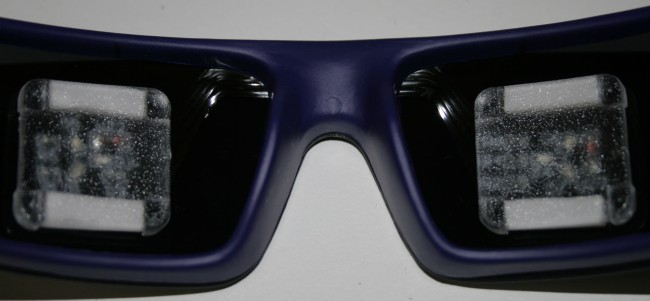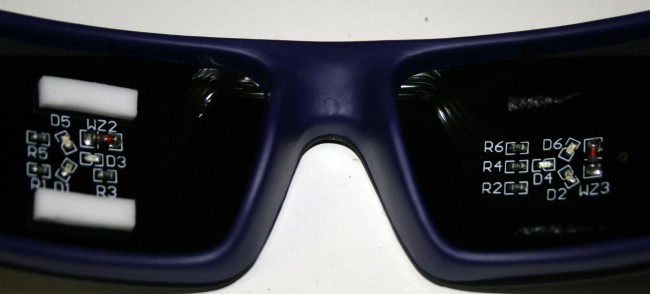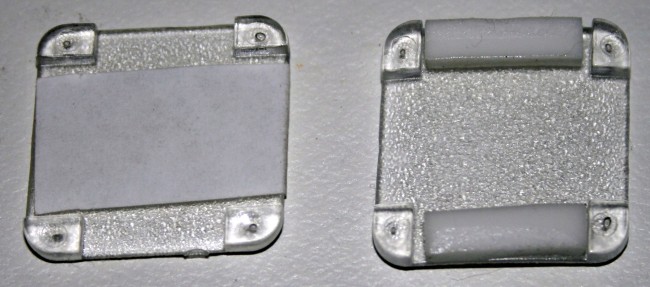There are a multitude of ways to diffuse the LEDs to provide a useful open-eye experience. There is an important distinction between open-eye and ganz feld application. The first is just that and usually involves running sessions just like closed-eye except in oh! wow! pretty colors. Ganz feld more typically requires an evenly illuminated field of vision and a willingness to stare at nothing until your mind can handle it no more, whereupon very strange effects can arise. For true ganz feld full spectrum white light is optimal – being a decent reproduction of the Arctic/Antarctic white-out condition from which the term was derived. True ganz feld must be open-eye and is easily reproduced by wrapping a piece of white paper across the eyes and lying in the sun – or any of the many split table tennis ball and other well known variants. Colored ganz feld with open-eye glasses without flashing is fine too.
This hack is intended for the former application. It does not provide full field, although in a dark room and as long as they eyes aren’t darting all over the place (which they shouldn’t be anyway if decent results are to be expected). Of the ridiculously easy ways to adapt an ordinary pair of GanzFrames for open-eye use, this is among the best I’ve tried. Of course, this hack is suitable for any GanzFrames – even the monocolor (Sirius) and bicolor (Proteus) ones will deliver good results. The result is certainly sufficient to give a good impression of the usefulness of open-eye for standard session use.
Keep in mind that open-eye is a bit silly below 10Hz (or more precisely, your blink frequency, dominant alpha) because keeping the eyes open brain activity dominates, diminishing the effect of lower frequency beats and suppressing true trance states. That said, all sorts of strange mental twists can be experienced at all flash rates – well worth exploring. Open-eye of any type is optimal for beta applications.
This is a fully reversible hack – no reason to sacrifice anything.
You will need a pair of GanzFrames and a sheet of self-adhesive inkjet paper (or equivalent). This paper is ideal because it is thin, relatively opaque for its thickness and, most conveniently, it’s adhesive.
Here we go…
Step 1.
The back of a standard pair of GanzFrames as we know and love them. You’re about to pop off the diffusers.
Step 2.
Diffusers removed – it just takes a little leverage under one side and the adhesive pads will let go. It doesn’t matter which side parts.
Step 3.
The diffusers removed. One has a layer of self adhesive inkjet label paper applied to the back/underside, between the adhesive pad locations.
Step 4.
Diffusers refitted – the adhesive pads are good for a few uses providing reasonable care is taken. Another layer of self adhesive inkjet paper is applied to the inner/eyeward surface of the diffusers (RH shown complete). This layer can be extended beyond the diffuser for a slightly larger field. As I’ve said, I prefer to make experimental toys as roughly as purpose/proof-of-concept permits.
Step 5.
And that’s that. You can probably see a vague green glow in the photo – it looks surprisingly good when millimeters from the eyeball.
Have fun!
Cheers,
Craig





Comments
Open-Eye GanzFrame like the mindspa device? it is possible tu just buy there ganzframe and use some type of adaptor for the kasina? thanks
Hi Leandro,
Chances are you can apply the hack to any glasses with a little inventiveness.
If I recall correctly, the MindSpa uses bicolor glasses, which would be most similar to the MindPlace red/green or red/blue GanzFrames. Most of the MP GanzFrames are available separately as accessories (all in due course).
The difference between devices is the polarity of the LED wiring – you will find details in my post “Glasses Maketh The Machine” – the polarities referred to as CG or CP.
Cheers,
Craig